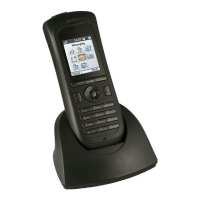TD 92930EN
13 December 2013 /Ver B
Configuration Manual
WL3 and WL3 Plus WLAN Handset
47
6. Handset Configuration
TTR starts when a message is displayed and continues to run when the message is
placed in the messaging queue. If a user presses any key when a message is
displayed, the TTR is reset. See also
6.8.2 Examples of TTR/TTP settings on page
50.
• Time to prioritize (TTP)
Defines how long messages keep their priority status. The TTP starts when a
message is displayed. If a user presses any key when a message is displayed, the
TTP is reset. If receiving a message with higher priority than the displayed
message, the message with lower priority is placed in queue and its TTP is paused.
When the TTP elapses for a message, it is put last in the queue. See also
6.8.2
Examples of TTR/TTP settings on page 50.
• Repeat message indication
This parameter enables/disables message indications. It sets whether a message
indication is repeated until confirmed by the user or not. The current repetition rate
is 7 seconds. If the message itself contains a repetition, it overrides this setting.
• Vibrator for message during call
Defines if the handset vibrates when receiving messages during an ongoing call.
• Message alert during call
Defines if a message alert should be played when receiving a message during a
call.
• IM option mode
This parameter is used for older applications and sets that three soft keys are
placed automatically, i.e. on soft keys or in an option menu (list).
• Call priority
This parameter defines:
- whether call information presented on the display during an incoming, ongoing,
and outgoing call is suppressed when viewing a message
- whether an ongoing call is disconnected when receiving a PTT invitation with
Answer mode set to “Automatically”.
0 = Call indication overrides all messages and the ongoing call is never
disconnected (default).
1-9 = Comparison with message priority; highest priority is shown, and a PTT
invitation with higher priority causes disconnection of ongoing call.
10 = Call indication on the display is always suppressed and the ongoing call is
always disconnected by a PTT invitation.
The tables below show examples of priority settings and how they affect the
handset’s behavior.
Call prio PTT invitation
(prio)
a
Disconnection of ongoing call?
0 1 No, since this call priority setting overrides
all PTT invitations regardless of priority.
6 6 No, an ongoing call is not disconnected
when the priority is equal.
2 1 Yes, immediately since the PTT priority is
set to 1 and is also higher than Call priority.
3 2 Yes, after 10 seconds since the PTT priority
is higher than Call priority.

